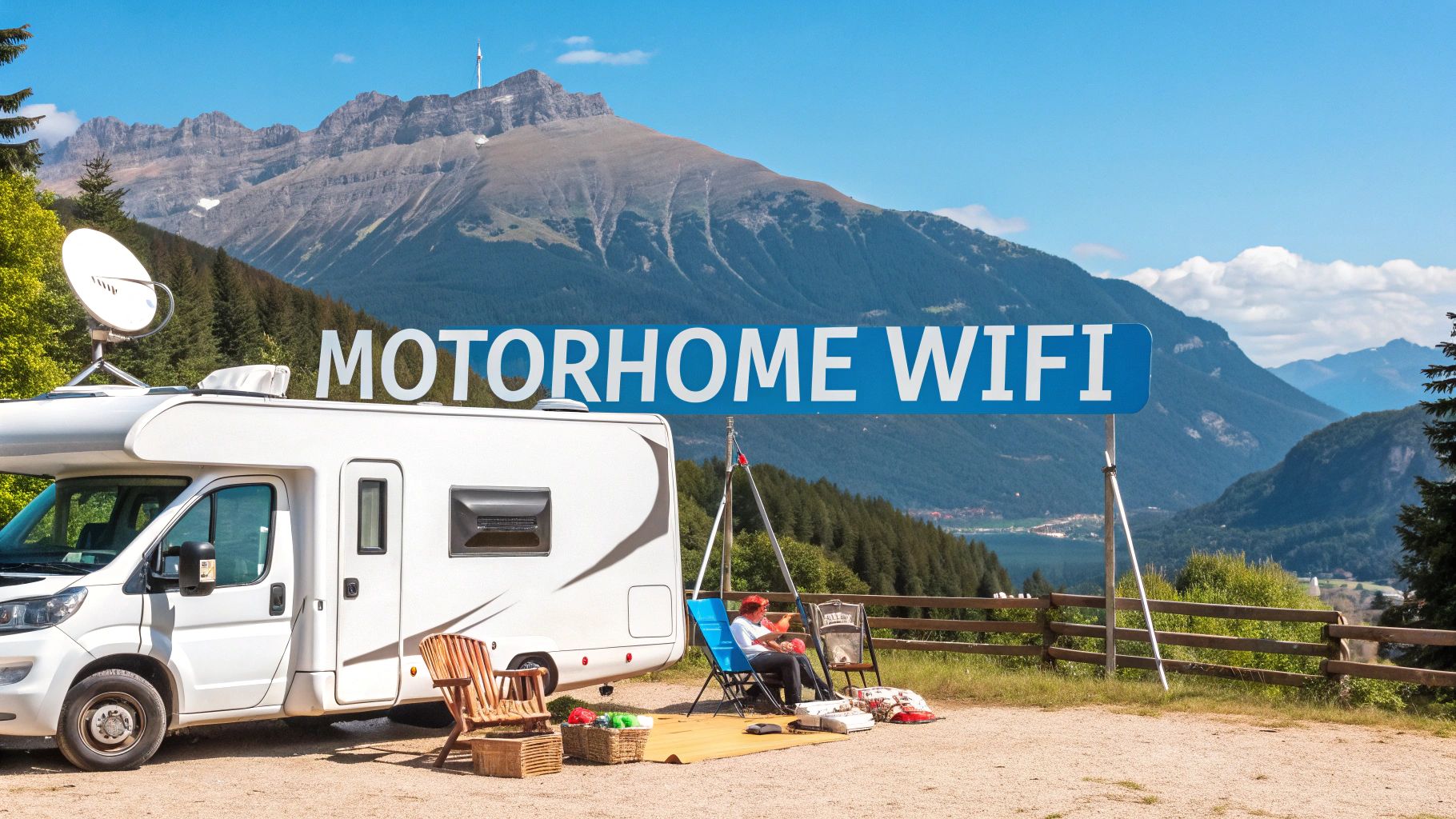

· By James
How to Get WiFi in a Motorhome: Easy Internet Solutions
Getting reliable internet in your motorhome isn't a one-size-fits-all deal. I've found that the best solution really comes down to how you travel. Your main options are cellular data (through hotspots or routers), tapping into public WiFi (made better with a booster), and satellite internet (like Starlink) for when you're truly off the grid.
Figuring out which one of these fits your life on the road is the secret to staying connected.
Your Motorhome WiFi Options At A Glance
Choosing the right WiFi setup for your motorhome boils down to a few simple questions: Where are you going? How much do you depend on the internet? And what's your budget?
For most of us on the road, it's a trade-off between using cellular networks, making the most of available public WiFi, or investing in a satellite system for total freedom. Each path has its own price tag, performance quirks, and best-case scenarios.
As you look at your options, learning how to choose an internet provider is a crucial first step. The same principles apply whether you're signing up for a new data plan or a satellite subscription.
Comparing Your Main Choices
So, let's break down the core solutions.
A dedicated cellular router is my go-to recommendation for anyone working remotely or for families who need solid, private speeds for streaming and browsing. It uses the same 4G and 5G signals as your phone but does a much better job of it.
Then you have public WiFi at campgrounds. It's often free, which is great, but the quality can be all over the place. A good WiFi booster can be a game-changer here, taking a weak, barely-usable signal and making it functional.
For the ultimate off-grid experience, satellite internet is the clear winner. It's how you get online in those beautiful, remote spots where cell service is just a memory. This image really puts the performance differences into perspective.
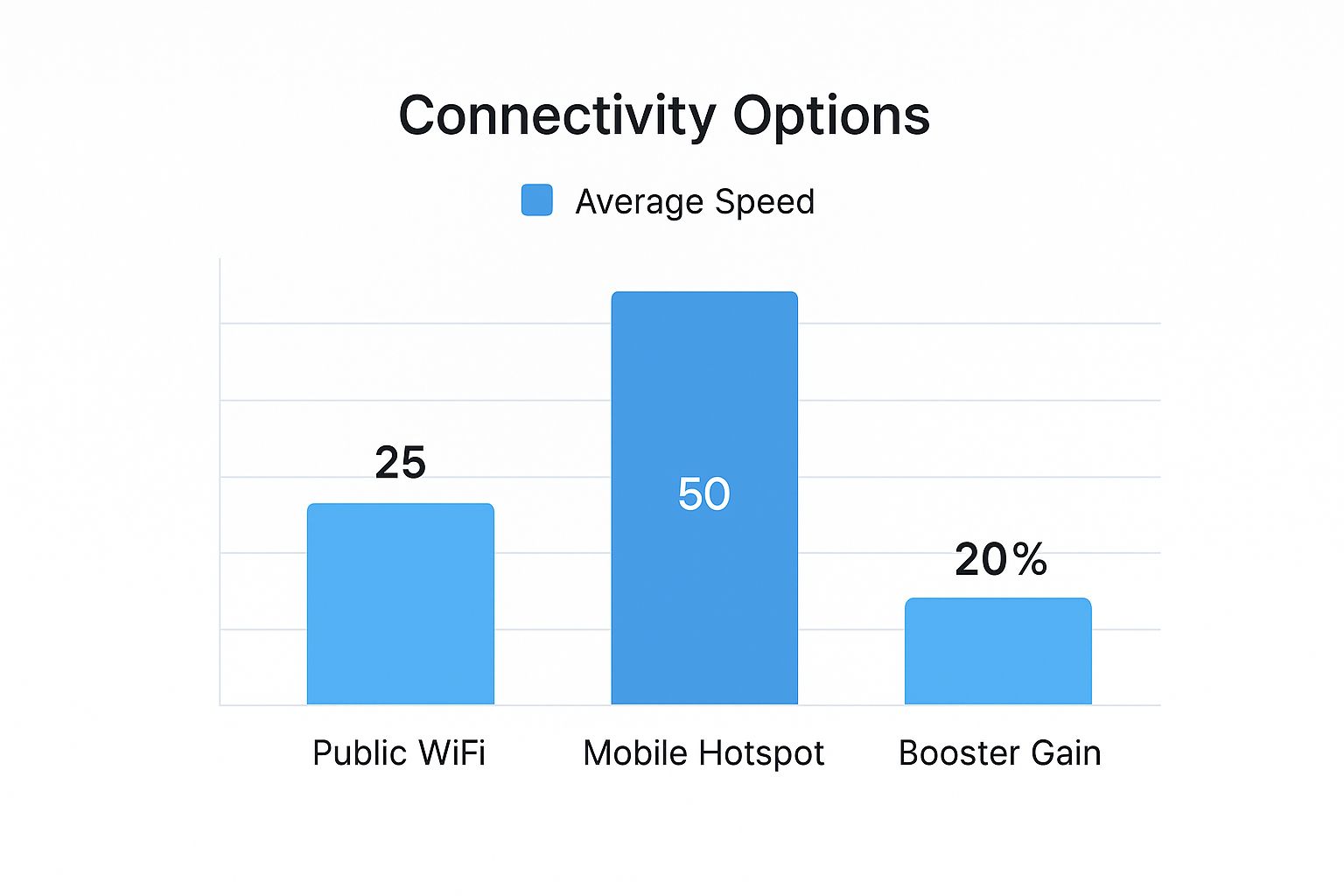
The numbers don't lie. A mobile hotspot can easily double the speed of the average campground WiFi. And if you add a booster to that public WiFi, you can see a major improvement.
My best piece of advice? Don't put all your eggs in one basket. Relying on a single connection type is a recipe for frustration. Having a primary method and a solid backup is just smart planning for any RVer.
To help you visualize the trade-offs, here’s a quick comparison of what you can expect from each option.
Comparing Your Motorhome WiFi Solutions
This table gives you a side-by-side look at the main ways to get internet on the road, covering everything from cost to where each system really shines.
| Connection Type | Typical Cost | Best For | Key Limitation |
|---|---|---|---|
| Cellular Router | $$-$$$ | Remote work, streaming, and full-time travel | Requires cell signal |
| Public WiFi + Booster | $-$$ | Budget-conscious travelers staying at campgrounds | Dependent on source signal quality |
| Satellite Internet | $$$$ | Off-grid exploring and remote locations | High upfront cost and requires clear sky view |
Ultimately, the right choice is the one that keeps you connected where and when you need it most.
For a much deeper look into these setups, be sure to check out our complete guide to the top connectivity options for your RV.
Using Cellular Data for Dependable Mobile Internet
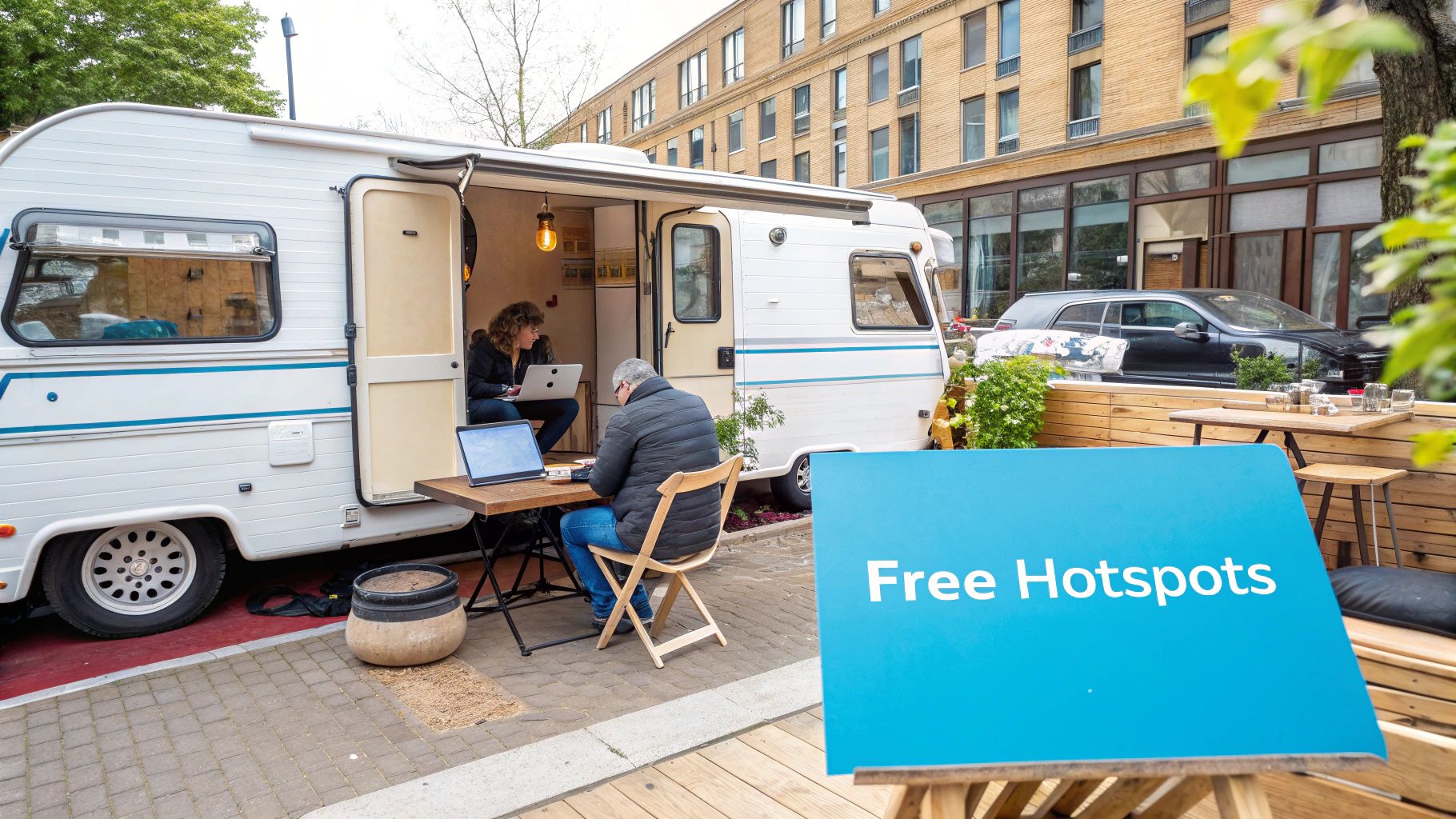 For most of us out on the road, cellular data is the backbone of a solid internet connection. It just hits the sweet spot between performance, flexibility, and coverage. You might be tempted to just tether your smartphone, and while that works in a pinch, it’s really just a temporary fix with some serious downsides.
For most of us out on the road, cellular data is the backbone of a solid internet connection. It just hits the sweet spot between performance, flexibility, and coverage. You might be tempted to just tether your smartphone, and while that works in a pinch, it’s really just a temporary fix with some serious downsides.
Let's be real: your phone isn't designed to be a full-time router. It can get hot, absolutely torch its battery, and the tiny antennas inside just can't compete with dedicated gear. On top of that, many so-called "unlimited" phone plans have surprisingly strict limits on high-speed hotspot data, dropping you to snail-like speeds after you’ve used just a few gigabytes.
This is where investing in dedicated hardware really changes the game, turning a frustrating, spotty connection into a reliable network for your entire motorhome.
Comparing Your Cellular Hardware Options
When you're looking to get Wi-Fi in your motorhome using a cellular signal, you've got a couple of great choices that go way beyond your phone. Each one fits a different kind of RVer and budget.
A mobile hotspot, sometimes called a MiFi, is a small, battery-powered device that creates a Wi-Fi network from a cellular signal. It's a definite step up from your phone because it’s built for one specific job. But, it still has internal antennas and is really best for folks who need a simple, grab-and-go solution.
The most powerful setup you can get is a cellular router with external antennas. These are permanently installed systems that pair a high-performance router inside your rig with antennas mounted on the roof. This setup dramatically boosts your ability to pull in a signal, especially in those fringe areas where a phone or portable hotspot wouldn't stand a chance.
A dedicated router isn't just a convenience; it's a strategic upgrade. If you work from the road or have multiple people streaming and browsing, the stability and performance boost are non-negotiable for a peaceful, buffer-free trip.
Choosing the Right Data Plan and Carrier
Your hardware is only half the battle. The data plan and cellular carrier you pair it with are just as important. Believe me, not all data plans are created equal, especially when it comes to the demands of motorhome life.
Here are the key things I always look for:
- Truly Unlimited Data: You need a plan designed specifically for hotspots or routers that doesn’t have sneaky throttling policies. I've found that reseller plans or even business accounts often have much better options for heavy data users.
- Carrier Coverage: Don't just commit to one carrier and cross your fingers. Before you go anywhere, pull up the coverage maps for the major providers. Many full-timers, myself included, carry SIM cards for at least two carriers (like Verizon and T-Mobile) and swap them out depending on who has the better signal at our campsite.
- Device Compatibility: Make sure your router or hotspot is actually certified to work on your carrier's network. It's a simple check that can save you a ton of connectivity headaches later.
The tech behind all this is moving fast, too. The market for devices that support the newer, faster frequency bands is getting bigger every day. As you're picking your gear, it's smart to see how the industry is moving toward next-gen tech. You can read more about the massive market adoption of Wi-Fi 7 capable devices to get a sense of how your connection could get even better in the near future.
Putting together the right cellular system is one of the best investments you can make for your travels. For some proven recommendations, check out our list of the 7 best mobile WiFi for motorhomes to keep you connected wherever you roam.
Making the Most of Public WiFi with Signal Boosters
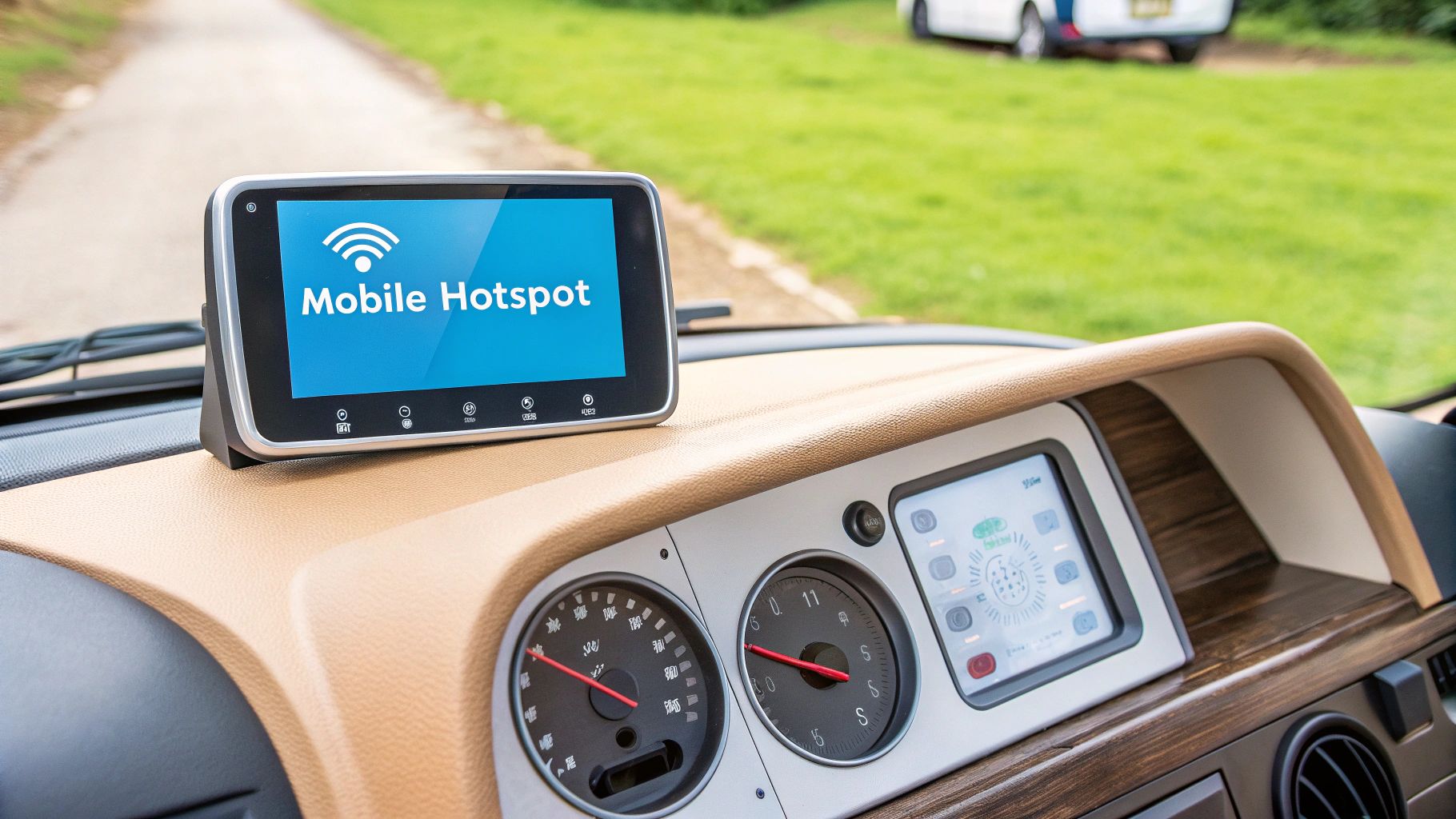
Let's be honest, relying on campground WiFi can be a gamble. It’s often the easiest and cheapest way to get online, but anyone who’s tried to stream Netflix from the back row of a packed RV park knows the pain of a weak, unreliable signal.
This is where a good signal booster becomes a game-changer for your travels. These devices grab that faint public WiFi signal from the campground office or community center and transform it into a strong, secure, and private network right inside your motorhome.
Think of it as your own personal hotspot, but instead of using pricey cellular data, it’s piggybacking on the campground’s internet. Suddenly, that frustratingly slow public connection becomes a stable link for all your gear—laptops, phones, smart TVs—without the hassle of logging each device in separately.
Installing Your WiFi Booster for the Best Signal
Proper setup is everything when it comes to getting the most out of your booster. These systems usually have two key components: an outdoor antenna that snags the public WiFi signal and an indoor router that creates your personal network.
For the antenna to do its job, it needs a clear, unobstructed path to the signal source. I’ve found that mounting it on the roof of my motorhome or using a telescoping pole gives me the best performance. Getting it up high helps it see over other RVs, trees, and buildings that would otherwise block the signal.
I always do a temporary test run before drilling any holes. Just moving the antenna a few feet one way or another can be the difference between a buffer-free movie night and endless frustration. Find that sweet spot first.
Once the signal is captured, the indoor router works its magic. It creates your own password-protected network, which not only boosts the speed but also adds a crucial layer of security. Your devices connect to your private, encrypted network, not directly to the public one.
Practical Tips for Maximum Performance
Getting the hardware installed is only half the battle. A few simple tweaks to how you position and use it can make a world of difference.
Here’s my go-to checklist for a solid connection:
- Aim for the Source: If you can see the campground’s WiFi antenna, point yours directly at it. If not, slowly sweep your antenna in different directions and watch your system’s dashboard to find the strongest signal.
- Dodge the Metal: Radio waves and metal are not friends. Make sure your outdoor antenna is mounted away from big metal objects on your roof, like your AC unit or a satellite dish.
- Reboot First, Reposition Second: If your internet feels sluggish, don't immediately climb on the roof. Try a simple reboot of your booster system first. More often than not, this is all it takes to clear things up and re-establish a strong link.
By using a WiFi booster strategically, you can turn those free—but often flaky—public networks into a reliable and secure answer to the big question of how to get wifi in your motorhome.
Satellite Internet for True Off-Grid Connectivity
When your adventures truly take you off the map, far beyond the reach of the nearest cell tower, satellite internet isn't just a perk—it's your lifeline. This is the ultimate answer for how to get Wi-Fi in a motorhome, giving you a solid connection in places where cellular data is just a distant memory.
Modern systems, especially Starlink for RVs, have completely changed the game. Instead of trying to catch a faint signal from a ground-based tower, these setups talk directly to a fleet of low-orbit satellites. The result? High-speed internet in some of the most remote corners of the country.
This technology is a massive leap forward. But it’s crucial to understand the day-to-day reality of using it. This isn't a simple "set it and forget it" system like a cellular router; it requires a bit of hands-on effort every single time you pull into a new campsite.
What You Need and How It Works
The heart of any satellite internet setup is the dish, which you'll often hear called a "dishy." This piece of hardware is your physical link to the satellites zipping by overhead. Every time you park your motorhome, you'll need to find a good spot for the dish outside—one with a wide-open, clear view of the sky.
This is the biggest practical hurdle. Trees, buildings, and even the steep walls of a canyon can block the signal and keep you offline. I’ve definitely had to spend time scouting different campsites just to find one with an unobstructed northern sky view. Once you’ve got it positioned, the dish automatically aims itself to lock onto the satellite network.
Satellite internet is for the serious explorer who refuses to let a lack of cell signal dictate their travel plans. It's the price you pay for true freedom, enabling you to work, stream, or connect from places you once could only dream about.
This kind of freedom is a big deal, as reliable internet remains a major challenge in many parts of the world. Globally, internet access is limited in rural areas, where more than half of the population remains offline. That’s a significant issue for motorhome owners who love to explore these exact places.
The Realities of Using Satellite on the Road
While the performance can be absolutely incredible, there are some practical limits to keep in mind.
- Cost: The first is the price tag. Satellite hardware has a pretty high upfront cost, and the monthly subscription fees are almost always more expensive than a typical cellular plan.
- Power: You'll also need to think about power consumption. The dish and router draw a fair amount of electricity, which is a major factor if you're boondocking and living off your battery bank.
- Weather: Severe weather can also play a role. Very heavy rain or snow can temporarily disrupt your signal, though thankfully, these outages are usually brief.
Despite these hurdles, the benefits are undeniable for a certain kind of RVer. If your goal is to venture deep into national forests, empty desert landscapes, or anywhere else cell service is non-existent, satellite is easily your most dependable choice. It truly opens up a world of possibilities for remote work and extended off-grid living.
For those considering this powerful solution, it's worth exploring all your options. To help with your decision, check out our guide on the top satellite internet for RV options currently on the market.
Fine-Tuning Your Setup for Peak Performance
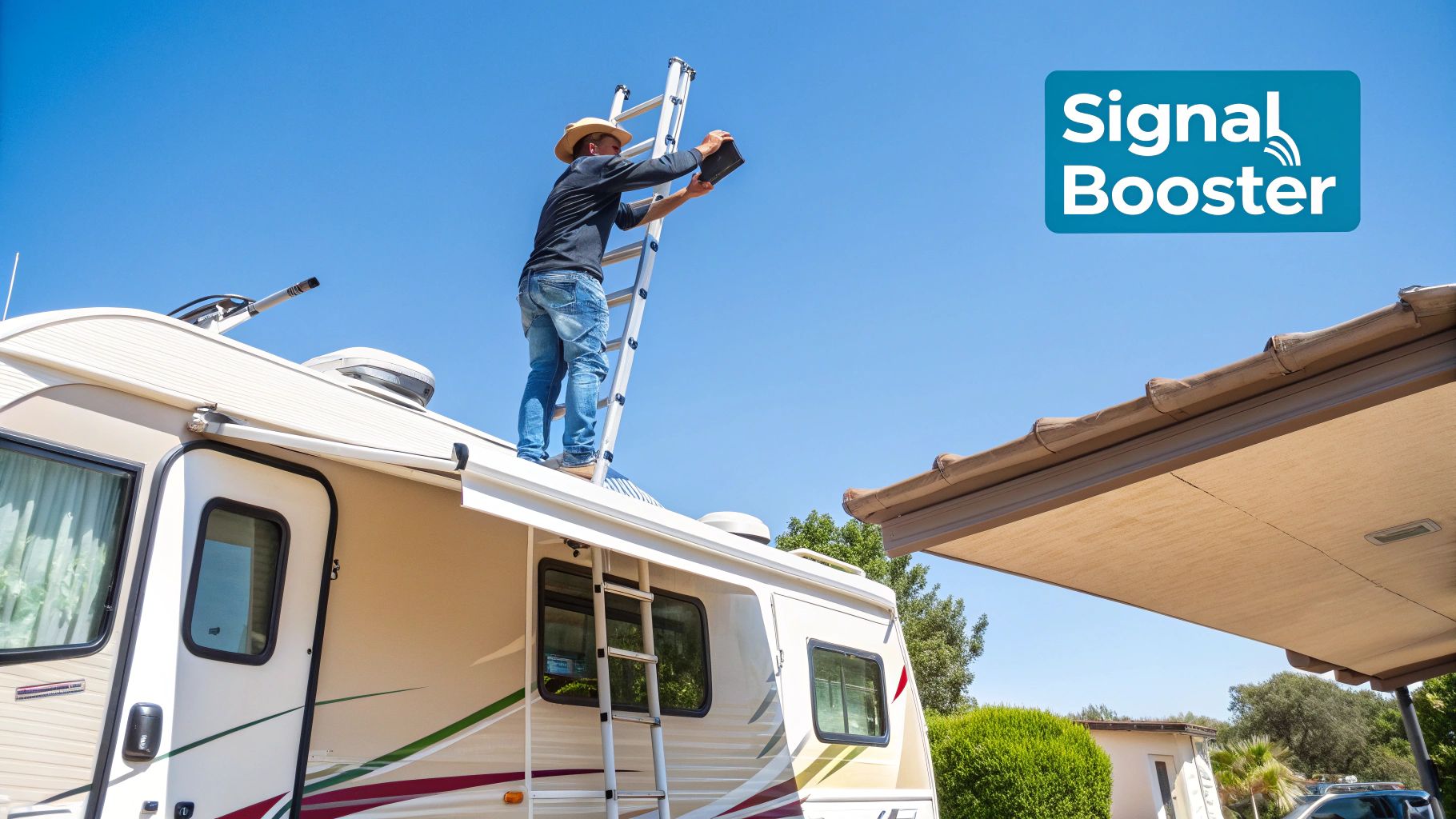 Choosing your hardware is a massive step, but the real magic happens when you start dialing in your system. Getting reliable Wi-Fi in a motorhome isn't a "set it and forget it" kind of deal. From my experience, it’s an ongoing process of small tweaks that add up to huge gains in speed and stability.
Choosing your hardware is a massive step, but the real magic happens when you start dialing in your system. Getting reliable Wi-Fi in a motorhome isn't a "set it and forget it" kind of deal. From my experience, it’s an ongoing process of small tweaks that add up to huge gains in speed and stability.
One of the best strategies I’ve learned is to build in redundancy. Instead of putting all your faith in a single connection, savvy RVers create a system with automatic failover. This just means your router can instantly jump from your main cellular connection to a backup—like the campground Wi-Fi or even a satellite link—the second that primary signal wavers.
This simple setup takes all the stress out of losing your connection mid-video call or right at the good part of a movie. It's the ultimate safety net for anyone who truly depends on staying online.
Proactive Signal Hunting and Security
You can give yourself a huge leg up before you even unhitch. I never just pull into the first open campsite I see. Instead, I’ll grab my phone, open a signal meter app, and take a quick walk around the campground to find the spot with the best cellular reception for my carrier.
This five-minute check can honestly be the difference between blazing-fast internet and a night of buffering frustration. Once you’re parked, locking down your network is just as vital. You absolutely have to change the default admin password on your router and set a strong, unique WPA3 password for your Wi-Fi network.
Your motorhome Wi-Fi network is your digital front door on the road. Leaving it unsecured is like leaving your physical door unlocked in a crowded campground. Take a few moments to lock it down tight.
Beyond the digital side of things, your power supply is a surprisingly critical factor. To keep your Wi-Fi gear running smoothly, especially when you're off-grid for a while, you need a solid power source. It’s worth taking the time for understanding the types of batteries you can have in your rig, as this directly impacts your connectivity.
Future-Proofing Your Motorhome WiFi
The tech that powers our mobile internet is always getting better, and it really pays to think ahead. When you're shopping for hardware, look for devices that are ready for what's coming next.
For example, the new Wi-Fi 7 standard was recently certified, and it promises some seriously fast speeds and much lower latency—a game-changer for how we get Wi-Fi in a motorhome. It’s expected that 2.1 billion devices will support it by 2028. This rapid adoption is going to dramatically improve the quality of networks available to us on the road.
Picking modern, compatible hardware today is a smart long-term investment. It means your setup won’t feel ancient in a year or two, and you’ll be able to take full advantage of network upgrades as they roll out, keeping you connected faster and more reliably wherever your travels take you.
Common Questions About Motorhome WiFi
Even with the best gear and a solid plan, questions are bound to pop up when you're getting your motorhome WiFi dialed in. It's totally normal to wonder if you've made the right call or if there's an easier way to get connected on the road.
Let's dig into some of the most common questions we hear from fellow RVers.
Can I Really Use My Phone's Hotspot for Full-Time Work?
This is probably the number one question we get, and for good reason. Using your phone's hotspot is convenient, and it's a fantastic backup for quick tasks. But for the demands of full-time remote work or keeping a family entertained? It usually falls short.
For one, phones aren't designed to be routers. They can easily overheat when working that hard for hours on end. Plus, their small internal antennas just can't pull in a signal as effectively as a dedicated cellular router.
The biggest issue, though, is the data plan fine print. Those "unlimited" phone plans almost always have a catch: a surprisingly low cap for high-speed hotspot data. Once you hit that limit—often just 15-30GB—your speeds are throttled to a crawl. Good luck with that important video call then.
What's the Difference Between a WiFi Booster and a Cell Booster?
This is another huge point of confusion, and getting it wrong is a frustrating and expensive mistake. They might sound similar, but they do completely different jobs.
A WiFi booster grabs an existing WiFi signal—like the one from the campground office or a coffee shop—and rebroadcasts it as a new, private network inside your rig. It strengthens a WiFi signal that's already there.
A cell booster, on the other hand, takes a weak 4G or 5G cellular signal from a distant tower and amplifies it. This improves the signal for your phones and your cellular router, giving you more bars and faster data speeds.
Think of it this way: if the problem is the campground's weak WiFi, a WiFi booster is your tool. If the problem is you only have one bar of cell service, you need a cell booster. If you're running into issues, this guide to troubleshooting WiFi connection issues can help you figure out if the source or your gear is the problem.
Is Satellite Internet Worth the High Cost?
This really boils down to your travel style.
If you mostly stay in campgrounds or areas with decent cell coverage, satellite is probably overkill. You can get a fantastic, reliable connection for much less money using a quality cellular setup.
However, if your dream is to explore those truly remote, off-grid spots where cell service is a distant memory, a system like Starlink is an absolute game-changer. The high price tag buys you the incredible freedom to be reliably connected just about anywhere you can see the sky.
For most of us, the best approach is a layered one, creating a toolkit for any situation.
- Primary Connection: A powerful cellular router for 90% of your travels.
- Backup Option: A WiFi booster to snag free campground WiFi when it's available and decent.
- Ultimate Freedom: A satellite system for those epic, off-the-beaten-path adventures.
This multi-pronged strategy ensures you’re never without a connection, no matter where the road takes you.
For a powerful and reliable 5G connection designed for RV travelers and rural living, SwiftNet Wifi offers high-speed internet solutions to keep you connected wherever you roam. Check out our plans and hardware at https://swiftnetwifi.com.

